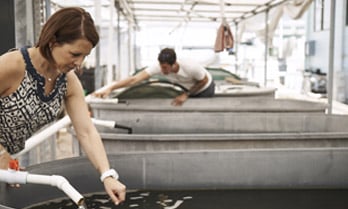Dr Rowena Martin, The Australian National University, Canberra/The University of Melbourne
01 September 2011
Fighting back against malaria
In the 1950s it seemed as if medical science was winning the fight against malaria with the help of the ‘wonder drug’ chloroquine. Over the past half century the drug has saved hundreds of millions of lives.
But now the parasite that causes malaria has fought back. Chloroquine-resistant malaria has become common in developing countries. Rowena Martin is working to understand what happened, and to develop new ways of treating malaria.
In a series of discoveries, Rowena and her colleagues at the Australian National University have revealed some of the biochemical tricks the malaria parasite uses. Her L’Oréal For Women in Science Fellowship allowed her to continue her study of the complex biochemistry that gives rise to resistance.
Qualifications
2005 – PhD (Biochemistry, cell physiology, molecular biology, and bioinformatics), TheAustralian National University (ANU)
1997 – Bachelor of Science with Honours (Biochemistry and cell physiology), ANU
Career highlights, awards, fellowships, grants
2010 – Australian Museum Eureka Prize Finalist for Early Career Research
2009-2012 – National Health and Medical Research Council Australian Biomedical Fellowship
2008-present – Principal investigator, Research School of Biology, ANU and the School of Botany, University of Melbourne
2008-2010 – National Health and Medical Research Council project grant: Characterization of the chloroquine resistance transporter of the malaria parasite
2007 – ASP & Australian Research Council/National Health and Medical Research Council Parasitology Network Early Career Researcher Award
2005 – Australian Research Council Research Associate, School of Biochemistry and Molecular Biology, ANU
2001 – Australian Society of Biochemistry and Molecular Biology ComBio Student Poster Prize
1998 – Australian Postgraduate Award
1996 – Research assistant, CSIRO Division of Forestry and Forestry Products, Canberra
1996 – Maternal Health Research Scholarship
1995 – Research assistant, New South Wales Agricultural Research and Veterinary Centre, Orange
1995 – National Heart Foundation Vacation Scholarship
1994 – Research Assistant, CSIRO Division of Plant Industry, Canberra
Research highlights
- More than ten presentations at Australian and international conferences and institutions including three invited conference and seminar presentations
- Thirteen publications including six first-author journal articles, three reviews and two book chapters
- A first-author paper in Science and a co-first-author paper in Nature
- Actively involved in editorial and peer review for a variety of journals and grants
- Currently supervising several PhD and Honours students
Top five publications
Martin RE (corresponding author), Marchetti RV, Cowan AI, Howitt SM, Broer S, and Kirk K. (2009) Chloroquine transport via the malaria parasite’s ‘Chloroquine resistance transporter’. Science, 325, 1680-82. (IF = 29.747; 7 cites)
Saliba KJ (co-first author), Martin RE (co-first author), Broer A, Henry RI, McCarthy CS, Downie MJ, Allen RJW, Mullin KA, McFadden GI, Broer S, and Kirk K. (2006) Na+-dependent uptake of an essential nutrient by the intracellular malaria parasite. Nature, 443: 582-85. (IF = 34.48; 23 cites)
Martin RE and Kirk K. (2007) Transport of the essential nutrient isoleucine in human erythrocytes infected with the malaria parasite Plasmodium falciparum. Blood, 109: 2217-24. (IF = 10.555; 19 cites)
Martin RE and Kirk K. (2004) The malaria parasite’s chloroquine resistance transporter is a member of the drug/metabolite transporter superfamily. Mol. Biol. Evol., 21: 1938-49. (IF = 9.872; 66 cites)
Martin RE, Henry RI, Abbey JL, Clements JD, and Kirk K. (2005) The ‘permeome’ of the malaria parasite: an overview of the membrane transport proteins of Plasmodium falciparum. Genome Biol., 6: R26. (IF = 6.626; 52 cites)




